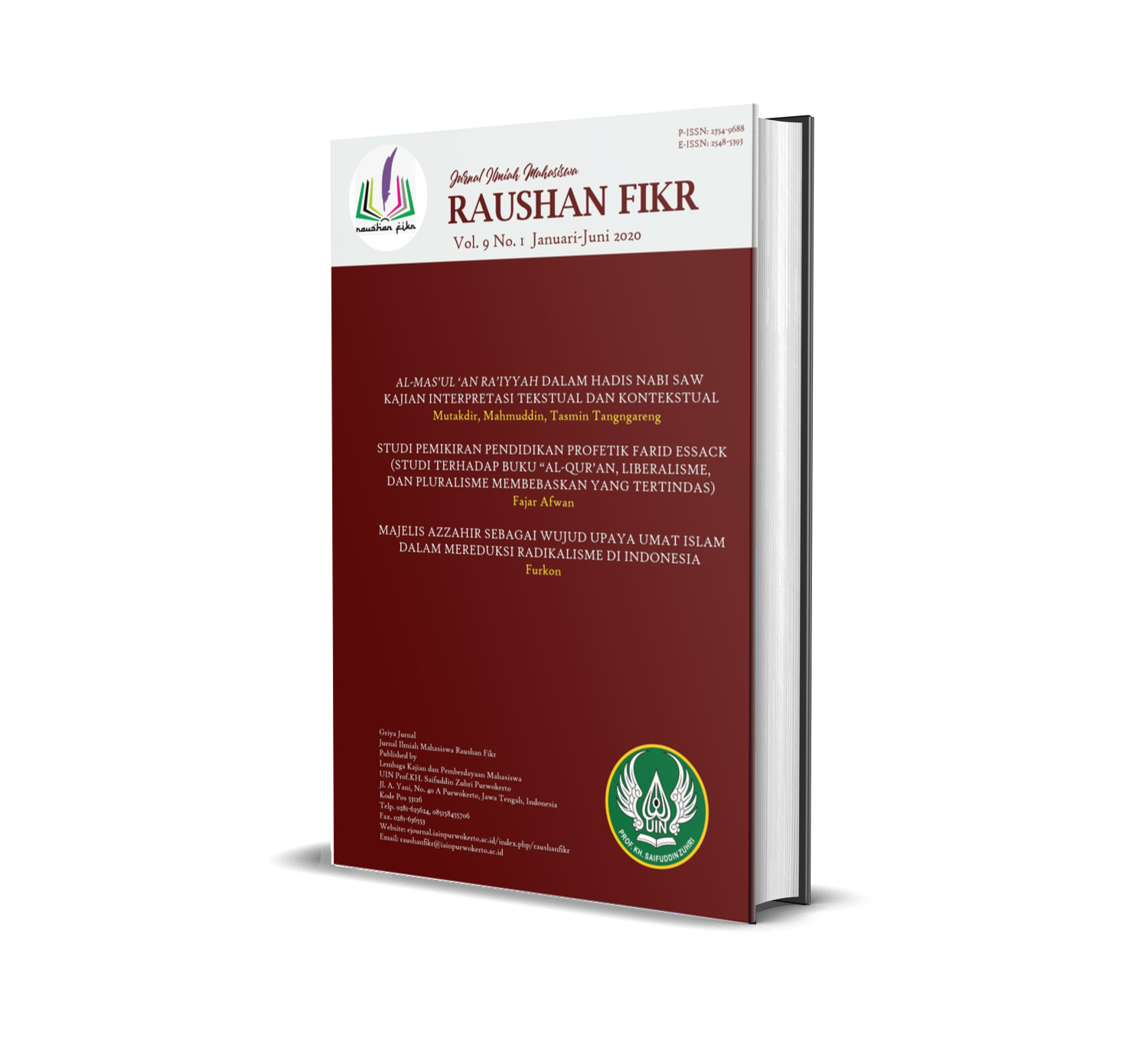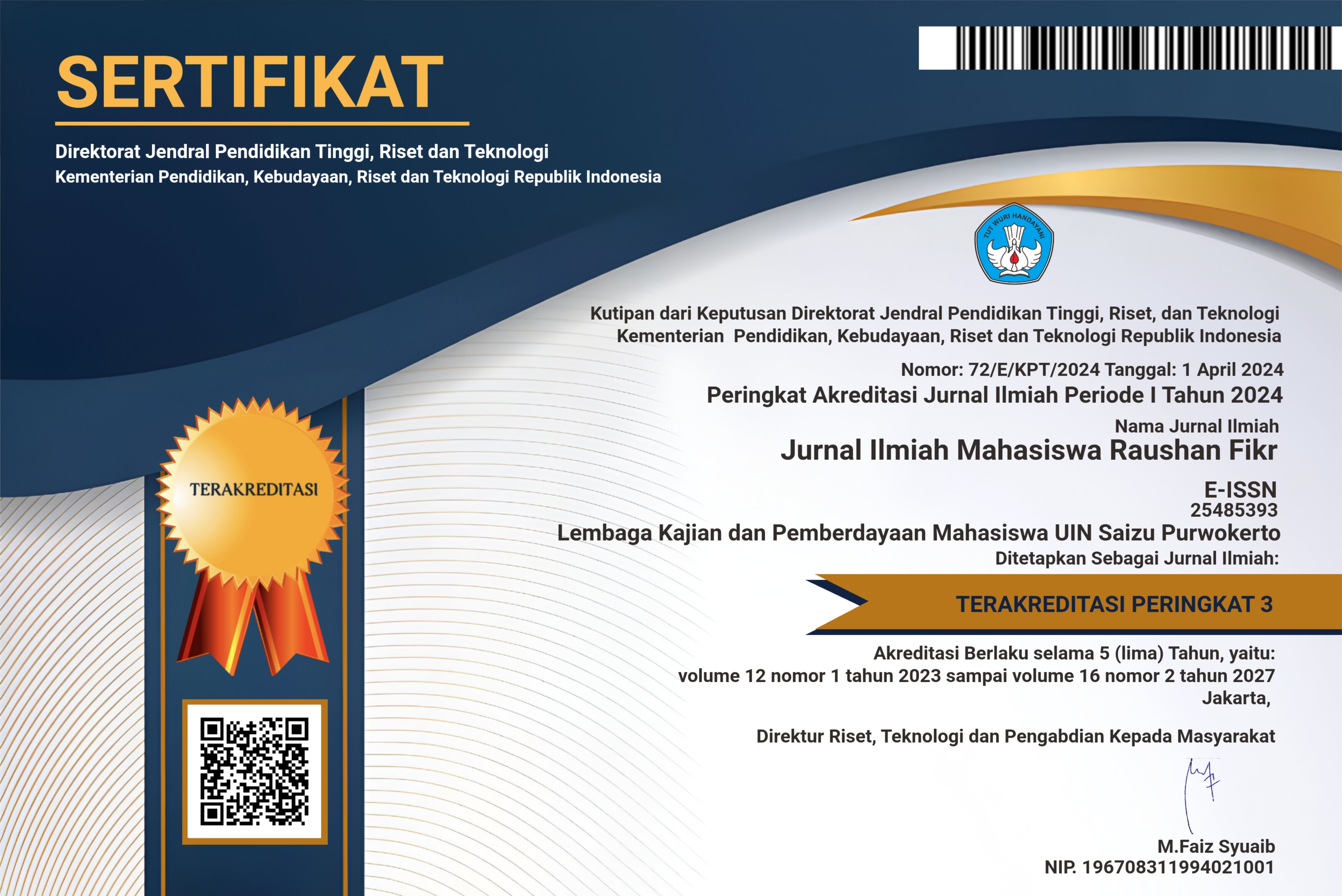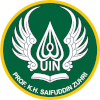AL-MAS'UL 'AN RA'IYYAH DALAM HADIS NABI SAW (Kajian Interpretasi Tekstual dan Kontekstual)
DOI:
https://doi.org/10.24090/jimrf.v9i1.4124Keywords:
Tanggungjawab, Pemimpin, dan HadisAbstract
This writing aims to describe al-Maus’ul ‘an Ra‘iyyah in prophet’s hadis (Textual and Contextual Interpretation Studys). Sentence al-Mas’ul ‘an Ra‘iyyah means a leader’s respomsibility. In hadith mentioned that all in the world is leader and will be asked his responsibility in here after. Human being created by Allah, has two big tasks and responsibility. First: as a servant who is obliged to increase worship. Second: as a messenger. Task and responsibility is trustworthy Allah, honestly many human being skill in carrying out the trustworthy so that responsibility report rejected by Allah. Thats why, to further analyze about al-Mas’ul ‘an Ra‘iyyah in hadith prophet saw. the auther collects meaningfull data Ra‘iyyah (leader) by searching hadith’s saw, in this process the researcher finded four terms, are term Khalifah, term Imam, term Ulim Amri dan term Sultan. Then the researcher analyzed the hadith al-Mas’ul ‘an Ra‘iyyah contained in the Sahih al-Bukhari, then Textual and Contextual Interpretation StudyDownloads
References
Ja‘fi, Muhammad Ibn Isma‘il Abu ‘Abdillah al-Bukhari al-. Al-Jami‘ al-Musnad al-Sahih al-Mukhtasar min Umur Rasulillah saw.=Sahih al-Bukhari. 4 ed. Kairo: al-Matba’ah al-Salafiyyah, 1403.
Kementerian Agama RI. Al-Qur‘an dan Terjemahnya. Surabaya: Pustaka Assalam, 2010.
Malik, Ibn Battal Abu al-Hasan ‘Ali Ibn Khalf Ibn ‘Abdi al-. Syarh Sahih al-Bukhari li Ibn Battal. III. Vol. 6. Al-Riyadh: Maktabah al-Rasydi, 1423.
Misri, Ahmad Ibn Muhammad Ibn Abi Bakr Ibn ‘Abdi al-Malik al-Qastalani al-. Abu al-‘Abbas Syihabuddin, Irsyad al-Sari Lisyarh Sahih al-Bukhari. VII. Mesir: Al-Matba‘ah al-Kubra al-Amiriyah, 1323.
Muhammad, Ali Ibn. Marqatu al-Mafatih Syarah Masykatu al-Masabih. I. Vol. 6. Baerut: Dar al-Fikr, 1422.
Naisaburi, Muslim Ibn al-Hajjaj Abu al-Hasan al-Qusyairi al-Naisaburi al-. Al-Musnad al-Sahih al-Mukhtasir Binaqli al-‘Adli ‘An al-‘Adli ila Rasulillah saw., Sahih Muslim. Vol. 3. Baerut: Dar Ihya‘ al-Tiras al-‘Arabi, t.t.
Sabhi, ‘Ali. , Al-Taswir al-Nabawi Lil Qayyim al-Khalifah wa al-Tasyri‘iyyah fi al-Hadis al-Syarif. Vol. 1. Maktabah al-Azhariyyah Littiras, 1423.
Sajistani, Abu Dawud Sulaiman Ibn al-Asy‘as Ibn Ishaq Ibn Basyir Ibn Syaddad Ibn ‘Amru al-Azdi al-. Sunan Abi Dawud. Vol. 3. Baerut: Al-Maktabah al-‘Asriyyah, t.t.
Suharso, dan Ana Retnoningsih. Kamus Besar Bahasa Indonesia. Semarang: Widya Karya, 2011.
Syafi‘i, Ahmad Ibn Isma‘il Ibn Usman Ibn Muhammad al-. Al-Kausar al-Jari ila Riyadh Ahadis al-Bukhari. I. Vol. 5. Baerut: Dar Ihya al-Turats al-‘Arabi, 1429.
Syaibani, Abu ‘Abdillah Ahmad Ibn Muhammad Ibn Hanbal Ibn Hilal Ibn Asad al-. Musnad al-Imam Ahmad Ibn Hanbal. I. Vol. 4. Kairo: Dar al-Hadis, t.t.
Tibi, Syarifuddin al-Husain Ibn ‘Abdllah al-. Syarh al-Tibi ‘ala Masykatu al-Masabih al-Musamma. I. Vol. 8. Al-Riyad: Maktabah Nuzur Mustafa al-Baz (Makkah al-Mukarramah), 1417.
Tirmizi, Muhammad Ibn ‘Is Ibn Surah Ibn Musa Ibn al-Dahhak al-. Sunan al-Tirmizi. II. Vol. 4. Mesir: Syarkatu Maktabah ‘Uwwad wa Matba‘ah Mustafa al-Bab al-Halbi, 1395.
Tirmizi, Muhammad Ibn ‘Isa Surah Ibn Musa Ibn al-Dahhak al-. Al-Jami‘ al-Kabir-Sunan al-Tirmizi. 4 ed. Baerut: Dar al-Garbi al-Islami, 1998.
Zakariyya, Abu al-Husain Ahmad Ibn Faris Ibn. Mu’jam Maqayis al-Lugah. Dar al-Fikr, 1979.
Zuhdi, Muhammad Harfin. “Konsep Kepemimpinan dalam Perspektif Islam.†Akademis 19, no. 01 (Juni 2014).
Downloads
Published
How to Cite
Issue
Section
License
Authors who publish with this journal agree to the following terms:
- Authors retain copyright and grant the journal right of first publication with the work simultaneously licensed under a Creative Commons Attribution-NonCommercial-ShareAlike 4.0 International License that allows others to share the work with an acknowledgement of the work's authorship and initial publication in this journal.
- Authors are able to enter into separate, additional contractual arrangements for the non-exclusive distribution of the journal's published version of the work (e.g., post it to an institutional repository or publish it in a book), with an acknowledgement of its initial publication in this journal.
- Authors are permitted and encouraged to post their work online (e.g., in institutional repositories or on their website) prior to and during the submission process, as it can lead to productive exchanges, as well as earlier and greater citation of published work (See The Effect of Open Access).
















